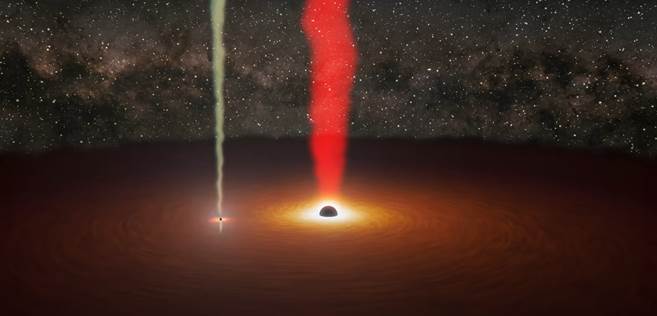A new study by 32 scientists from 10 countries (Finland, Poland, India, China, USA, Czech Republic, Japan, Germany, Spain, Italy) has identified the smaller black hole of a pair in the galaxy OJ 287, marking the first confirmed observation of an orbiting black hole.
Background
- Initial Theory Confirmation: International research groups had previously validated the theory proposed by astronomers at the University of Turku, Finland, that two black holes exist at the center of the galaxy OJ 287, located four billion light years away.
- NASA’s Involvement: In 2021, NASA’s Transiting Exoplanet Survey Satellite (TESS) was directed towards OJ 287 to support the confirmation of the two black holes.
TESS Satellite Observations
- TESS Mission: Designed to discover exoplanets, TESS has found 410 confirmed exoplanets. In 2021, it studied OJ 287, focusing on detecting the smaller black hole.
- Monitoring and Discovery: TESS monitored the brightness of the primary black hole and its jet, detecting a sudden burst of brightness that revealed the presence of the smaller black hole on November 12, 2021.
Predictions and Observations
- Predicted Event: Researcher Pauli Pihajoki from the University of Turku had predicted this event in his 2014 doctoral dissertation.
- Collaborative Efforts: Multiple satellites and telescopes, including NASA’s Swift telescope and an international team led by Staszek Zola, confirmed the observation.
Detailed Analysis
- Light Polarization: A group from Boston University, USA, confirmed the discovery by studying light polarization changes before and after the flare.
- Burst of Light: The burst, lasting 12 hours, indicated the smaller black hole “swallowing” a part of the accretion disk around the larger black hole, creating a bright jet of gas.
Significance of the Findings
- Visual Confirmation: This event allowed researchers to “see” the smaller black hole indirectly, similar to how TESS detects exoplanets.
- Future Observations: The smaller black hole is expected to emit nano-Hertz gravitational waves, potentially detectable by pulsar timing arrays in the coming years.
Visual Observations
- The burst showed a sharp flare in the light curve, equivalent to the brightness of about 100 galaxies. During the 12-hour period, the jet from the smaller black hole dominated, altering the usual reddish color to a yellowish hue.
Multiple Choice Questions (MCQs):
- What was the primary objective of the TESS satellite in 2021 regarding galaxy OJ 287?
- a) Discovering new exoplanets
- b) Confirming the presence of two black holes
- c) Studying the Milky Way galaxy
- d) Observing supernovae
- Which event confirmed the existence of the smaller black hole in OJ 287?
- a) A supernova explosion
- b) A burst of brightness observed by TESS
- c) Discovery of new exoplanets
- d) A collision between two stars
- Who predicted the flare event observed in OJ 287 in their 2014 doctoral dissertation?
- a) Shubham Kishore
- b) Alok C. Gupta
- c) Pauli Pihajoki
- d) Staszek Zola
- What significant change was observed in the color of OJ 287 during the 12-hour burst?
- a) Blue to green
- b) Red to yellow
- c) Yellow to blue
- d) Red to blue
- What is the anticipated future detection related to the smaller black hole in OJ 287?
- a) High-frequency gravitational waves
- b) Nano-Hertz gravitational waves
- c) New exoplanets
- d) A new galaxy
